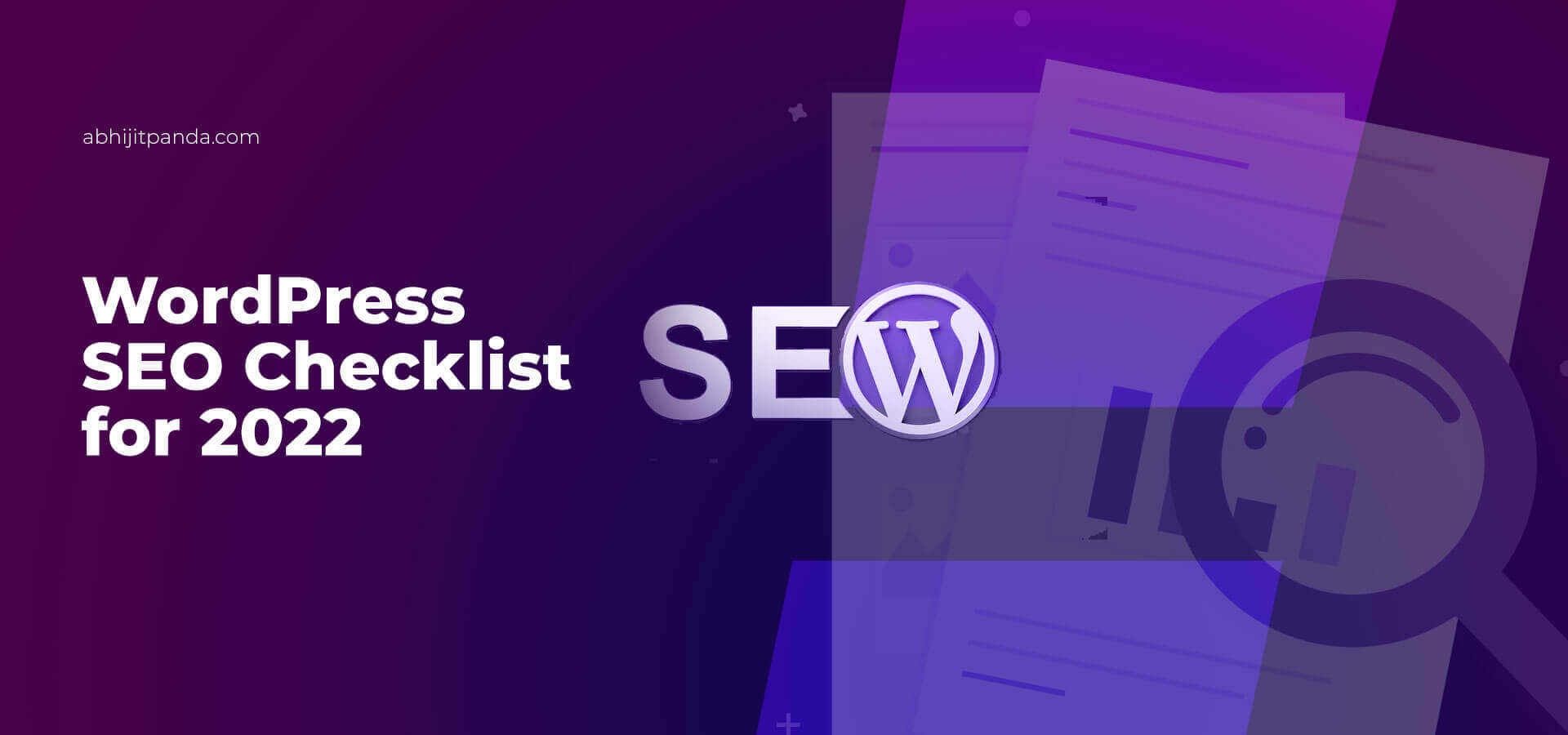 WordPress SEO Checklist for 2023
WordPress SEO Checklist for 2023
In 2023, individuals and enterprises will promote their websites through many digital marketing channels – search engines, social media, emails, display ads, and paid advertisements. But search engines are more effective in diverting organic and trackable traffic to websites than other digital marketing channels.
According to Search Engine Journal,
“53%: The percentage of all trackable website traffic that comes from organic search.”
Also, search engine optimization (SEO), unlike other digital marketing strategies, diverts traffic to websites organically and regularly over a period of time. That is why; companies and startups have been spending more and more on SEO services. You can easily divert search traffic to your websites regularly by implementing SEO strategies or availing of SEO services in 2023.
But you must remember that major search engines like Google change search algorithms around 500 to 600 times every year. Also, they add new ranking factors regularly to deliver the most relevant search results to searchers. That is why; you have to focus on a slew of factors while making and implementing SEO strategies in 2023.
WordPress is one of the content management systems (CMS) that help you to optimize your website for search engines without putting in extra time and effort. But you must prepare an elaborate WordPress SEO checklist to divert and grow your WordPress website’s organic traffic. You can refer to the SEO checklist to optimize web pages and blog posts according to the latest search engine guidelines and emerging SEO trends.
While preparing the WordPress SEO checklist for 2023, you must cover important SEO activities like on-page SEO, off-page SEO, keyword research, content optimization, and link building. Also, you must make the checklist more effective by including SEO tips and best practices. However, it is also important to keep the SEO checklist flexible enough to finetune SEO techniques and adopt SEO trends quickly and effortlessly.
WordPress SEO Checklist for 2023: 17 Practical Tips and Best Practices
1) Enable Search Engines to Crawl and Index
WordPress’s clear and simple source code makes it easier for search engines to crawl and index websites. But WordPress allows users to prevent search engines from crawling and indexing a website by disabling the search engine visibility option. While implementing SEO strategies, you must allow search engine bots to crawl and index your WordPress website effortlessly by making relevant changes in the robots.txt file.
2) Install the Right SEO Plugin
While preparing WordPress SEO checklists, webmasters and digital marketers often opt for the most popular SEO plugin for WordPress – Yoast SEO. Yoast is one of the mature SEO plugins that are used widely to optimize various websites. However, you have the option to choose from many new-age SEO plugins for WordPress. It is always important to spend some time choosing the best SEO plugin for your WordPress website. That is why; you must compare various WordPress SEO plugins using important parameters like features, compatibility, security, speed, and update frequency.
3) Make URLs Search Engine Friendly
Google recommends webmasters make bots crawl web pages without consuming more bandwidth by keeping the URL short and simple. While optimizing a post or page in 2023, you must check its URL to ensure that it does not contain unsafe characters. Also, you must keep the URL readable by replacing blank spaces with underscores and using either uppercase or lowercase. However, you must not forget to include the focus keyword in the URL while optimizing it according to search engine guidelines.
4) Use HTML Headings Accurately and Strategically
Accurate usage of heading tags (H1 to H6) is one of the key elements of on-page SEO strategies. Every heading tag conveys important information about your WordPress website clearly to the search engines. For instance, the H1 tag makes the search engine understand what the page post or page is about, while the H2 tag conveys information about a particular section on the web page. Every WordPress theme handles headers in a different way. That is why; you must review the page’s source code to ensure that the header tags are used accurately.
5) Identify and Find Relevant Keywords
Selection and optimization of keywords must be one of the key elements of your WordPress SEO checklist for 2023. You can accelerate keyword research using the options included in WordPress SEO plugins. Also, you can find long-tail keywords using Google Suggest and use Google Keyword Planner to find relevant and related keywords. However, you must not leverage social media and online forums to find fresh and untapped keywords. The information and trends collected from multiple online sources will help you to find the most relevant keywords.
6) Use and Include Relevant Keywords
After conducting keyword research, you have to optimize a page or post by including the focus keyword and secondary keywords strategically. Your WordPress SEO checklist needs to ensure that you include the focus keyword in the URL, title tag, tag modifiers, and H1 tag. Also, you must include the focus keyword in the first 100 to 150 words of the content. At the same time, you must use secondary keywords strategically in header tags. However, you must review and edit the content to ensure that the keywords are placed naturally and not stuffed.
7) Add Structured Data Strategically
In addition to improving the search experience, structured data make search engines understand a web page or blog post clearly. Major search engines these days boost the search experience by displaying structured data on SERPs in the form of rich snippets. You can boost the search visibility of a post or page by adding a variety of rich snippets – products, reviews, courses, recipes, events, how-to, businesses and organizations, and reviews and ratings. You can add structured data or rich snippets to a web page using WordPress plugins or structured data markup.
8) Analyze and Optimize Content
Your WordPress SEO checklist must focus on optimizing content for both search engines and searchers. You can attract and engage website visitors only by posting fresh, insightful, and readable content with no spelling or grammatical mistakes. At the same time, you need to optimize the page or post for search engines by keeping the content scannable and embedding keywords naturally. You can easily analyze the SEO-friendliness of the content using a slew of WordPress SEO plugins and online writing assistants. These tools help you to post SEO-friendly content by making changes and fixing mistakes.
9) Define the Page Title Clearly
Search engines display a web page’s title in the form of a clickable headline on SERPs. They display the page title in around 60 to 70 characters. That is why; you must focus on creating a page title that is short and contextual. While defining a page title in the H1 tag, you need to ensure that the page title conveys the nature and context of the title clearly to both search engines and searchers. At the same time, you must make the title SEO-friendly by including the focus keyword. It is always important to spend time creating a compelling page title and optimizing it for search engines.
10) Write and Finetune Meta Description
Unlike page titles, the meta description is not a search engine ranking factor. But searchers will decide about clicking on the page title only after reading the meta description appearing on SERPS. While writing a meta description, you should restrict its length to 160 characters. You still need to ensure that the meta description provides the searchers with a summary of the content. Also, you must not forget to optimize the meta description for SEO by embedding relevant keywords strategically. Here is a quick guide on meta description SEO best practices.
11) Create Internal Links
In your WordPress SEO checklist for 2023, you must focus on the web page’s internal and external link structure. Unlike external links, internal links can be created easily and organically by connecting the new web page to existing web pages. But you can boost a web page’s search visibility only by creating contextual internal links by connecting relevant and related web pages. At the same time, you must restrict the number of internal links to avoid passing excessive link juice. You can easily boost the web page’s internal link structure by adopting some simple best practices.
12) Build External Links to High Domain Authority Sites
Along with creating the internal link structure, you must focus on building high-quality external links using white-hat SEO techniques. While posting blogs, you must explore ways to link the web page to a relevant website with high domain authority. The external links must help readers to gather additional information related to your page or post. The leading SEO experts will advise you to include at least two external links to high-domain authority sites in a single page or post. However, you still need to ensure that the linked web page opens in a new tab when the reader clicks on the external link.
Here are some off-page SEO techniques for aspiring marketers.
13) Check and Maintain Keyword Density
Like keyword stuffing, higher keyword density often impacts a web page’s search performance directly. While optimizing the content and web page, you must focus on maintaining the right keyword density. The keyword density percentage recommended by individual bloggers and digital marketers differs. But you can easily check and modify keyword density using a WordPress SEO plugin. Most SEO plugins for WordPress help you to know the current keyword density along with making suggestions and recommendations.
14) Complement Text with Images and Videos
You can easily boost a web page’s search performance by leveraging the SEO benefits of images and videos. The multimedia content will help you to keep the visitors engaged. At the same time, you can easily boost your page or post’s SEO by optimizing the images and videos. However, it is important to choose and include multimedia content that complements the topic of the article or blog perfectly. Also, you can use images and videos to help readers understand complex concepts and analyze diverse information while reading the textual content.
15) Optimize Every Image for Search Engines
WordPress is one of the CMSs that comes with built-in options to help users handle and optimize images. While embedding images, pictures, or graphics into textual content, you need to ensure that the web page’s loading speed is not impacted. In addition to choosing the right image format, you must compress the image before uploading. At the same time, it is also important to optimize the images for search engines through the ALT tag. You can use the ALT tag to include the relevant keywords in the image description, along with keeping the image caption compelling. Here are some image SEO tips for savvy digital marketers.
16) Conduct Regular SEO Audits
The search visibility and performance of every WordPress website vary from time to time based on a variety of factors. You cannot boost your website’s search performance consistently without fixing the issues and factors impacting its performance. You can easily identify the issues affecting your website’s search visibility using a slew of SEO audit tools and plugins. Most of these tools and plugins help you to identify SEO lists without putting in extra time and effort. Your WordPress SEO checklist must focus on making SEO audit an ongoing activity in 2023.
17) Boost Your Website’s User Experience
In 2023, no webmaster can boost her WordPress website’s search visibility without improving its user experience (UX).
According to Search Engine Land,
“Think of the partnership of SEO and UX this way: SEO targets search engines, and UX targets your website’s visitors. Both share a common goal of giving users the best experience.”
While implementing SEO strategies, you must focus on key factors that impact the website’s user experience directly – loading speed, mobile accessibility, and site navigability. It is always advisable to test and boost your website’s UX before starting SEO.
The WordPress SEO checklist will make it easier for you to optimize web pages and blog posts in 2023. But you cannot boost lead generation and lead conversion without reviewing and updating the SEO checklist for WordPress websites from time to time. It is always important to keep the WordPress SEO checklist for 2023 flexible and dynamic enough to adopt SEO changes and trends proactively.
This article was republished in January 2023.









Leave a Reply